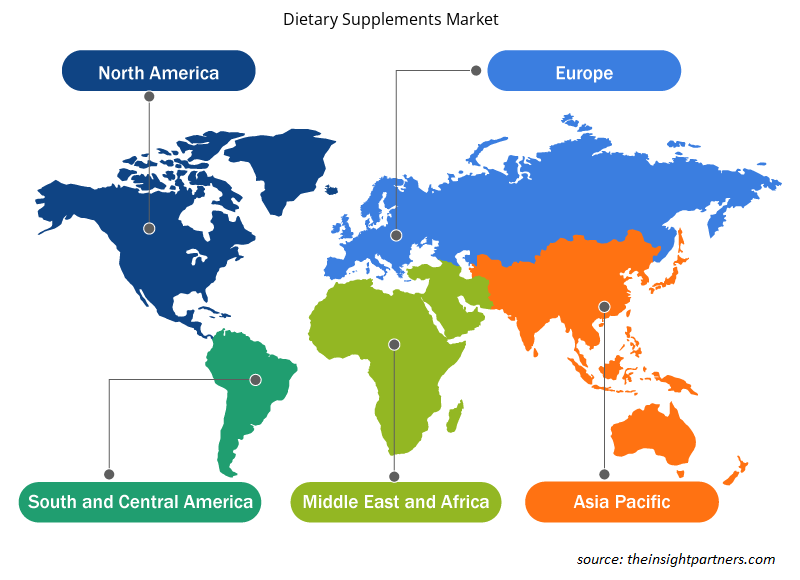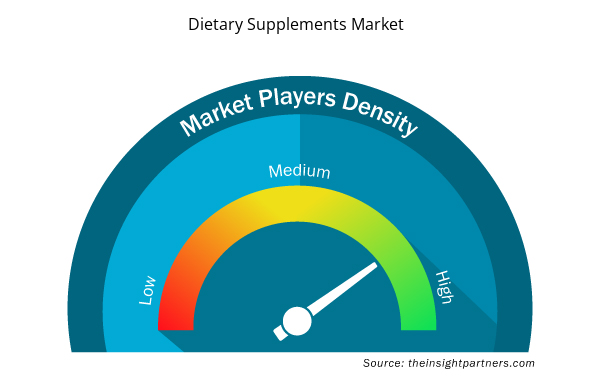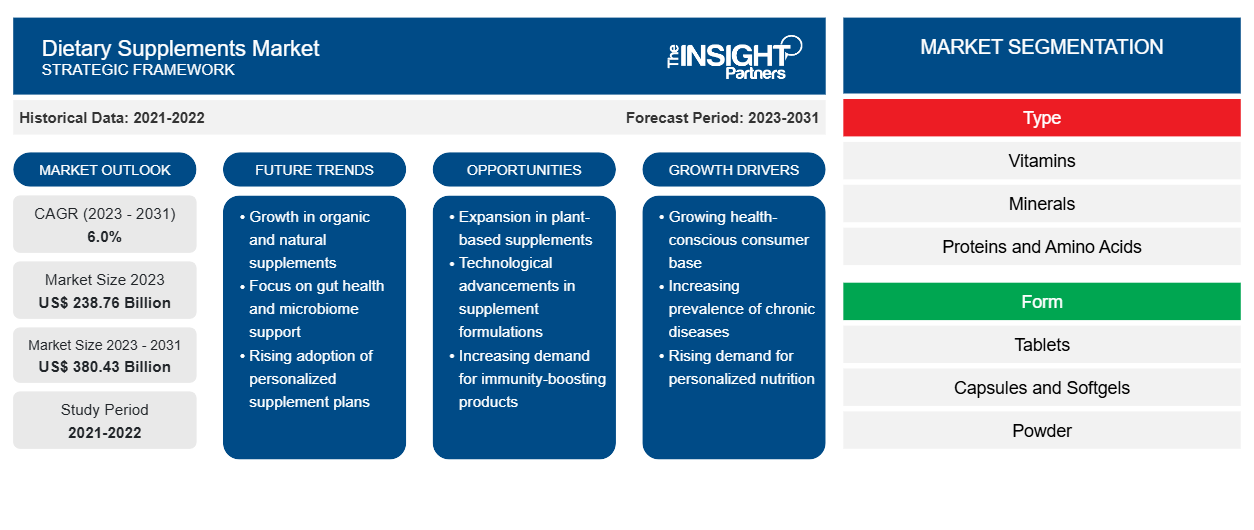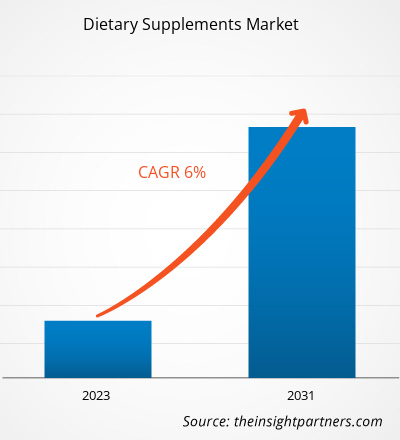膳食补充剂市场规模预计将从 2023 年的 2387.6 亿美元增至 2031 年的 3804.3 亿美元。预计 2023-2031 年市场复合年增长率为 6.0%。对植物性膳食补充剂和营养保健品的偏好日益增加可能仍将是膳食补充剂市场的主要趋势。
膳食补充剂市场分析
近年来,由于各种疾病(如癌症和心血管疾病)以及糖尿病、高血压、肥胖症和高胆固醇等多种疾病的患病率不断上升,健康和健身已成为一种趋势。所有这些都导致膳食补充剂在世界范围内越来越受欢迎。近几年来,人们对自己的健康和体质的认识和关注度不断提高。全球数百万不同年龄段、不同背景和不同地域的人都在健身,以改善身体健康和整体幸福感,这大大增加了对膳食补充剂的需求。例如,根据宾夕法尼亚大学医学院的数据,超过三分之一的美国公民使用补充剂,30% 的 65 岁及以上成年人服用四种或四种以上的补充剂。
此外,社交媒体在健身激励和影响自我提升方面也发挥着重要作用。例如,Instagram、Twitter 和 Pinterest 等社交媒体平台提升了健康和健身行业的知名度,许多名人和有影响力的人向用户介绍新的健身方案和膳食补充剂,强调它们对身心健康的好处,进而促进了膳食补充剂的需求。
膳食补充剂市场概况
膳食补充剂含有可提高其营养价值的成分。许多人使用膳食补充剂来帮助他们过上健康的生活方式。这些补充剂通常用于补充缺失的营养素,同时保持体内足够的饮食水平。膳食补充剂含有维生素、矿物质、蛋白质、氨基酸、益生菌等营养素。它们有不同的形式,如片剂、胶囊和软胶囊、粉末等。膳食补充剂有助于满足个人的特定营养需求。人们尤其是年轻人群对健康和健身的关注日益增加,是推动市场增长的关键因素之一。此外,体育和娱乐活动的日益增长以及对服用膳食补充剂的好处的认识不断提高也推动了全球膳食补充剂市场的增长。
定制此报告以满足您的需求
您可以免费定制任何报告,包括本报告的部分内容、国家级分析、Excel 数据包,以及为初创企业和大学提供优惠和折扣
- 获取此报告的关键市场趋势。这个免费样品将包括数据分析,从市场趋势到估计和预测。
膳食补充剂市场驱动因素和机遇
市场对草药和植物补充剂的需求不断增长
由于消费者对清洁标签产品的需求不断增长、对可持续性的担忧日益增加以及迫切需要避免过敏原,消费者的偏好正在转向植物提取物。这些草药补充剂的人口结构正在从纯素食者转变为弹性素食者,这表明消费者的倾向发生了变化。由于高度关注动物虐待和环境可持续性,消费者被鼓励转向植物性饮食。消费者认为植物性产品比动物源产品更安全、更健康,这种观念正在改变,这推动了对植物性膳食补充剂的需求。
增加新产品开发以提供有利可图的增长机会
近年来,膳食补充剂市场经历了各种技术进步。例如,传统的硬明胶胶囊和软明胶胶囊、锭剂、片剂、粉末和液体加入了其他几种补充剂形式,例如软糖、双层片剂或颗粒。由于产品创新的增加以及消费者对补充剂领域个性化需求的不断增长,消费者现在可以选择多种交付形式以适应他们的特定生活方式和偏好,为行业提供了解决吞咽问题和满足消费者日益增长的定制需求的选择。因此,制造商专注于创新,并推出不同形式和口味的新产品。例如,2020 年 10 月,雅培实验室最近在印度推出了 Duphalac Bears。该产品符合 FSSAI 法规,具有值得信赖的益生元的好处,并促进消化系统中健康细菌的生长,同时降低有害细菌的水平。该公司还在印度推出了草莓味食品补充剂,以支持该公司在该国的膳食补充剂系列。
膳食补充剂市场报告细分分析
有助于得出膳食补充剂市场分析的关键部分是类型、形式、分销渠道和地理位置。
- 根据类型,膳食补充剂市场分为维生素、矿物质、蛋白质和氨基酸、益生菌、混合物等。维生素部分在 2023 年占据了更大的市场份额。维生素是人体正常发育和运作所需的化合物。一些常见的维生素是 A、C、D、E、K、胆碱和 B 族维生素(硫胺素、核黄素、烟酸、泛酸、生物素、维生素 B6、维生素 B12 和叶酸/叶酸)。最近,由于工作专业人士和运动员对能量和体重管理的需求日益增加,对维生素的需求有所增加。维生素 A、B、C 和 E 缺乏症在许多发展中国家也变得越来越普遍。因此,消费者开始转向维生素补充剂来满足他们的日常维生素需求,从而促进了这一细分市场的增长。复合维生素有多种形式,如液体、片剂和粉末,可供所有年龄段的人食用。
- 根据分销渠道,膳食补充剂市场细分为超市和大卖场、专卖店、在线零售和其他。专卖店部分在 2023 年占据了更大的市场份额。专卖店部分包括药店和营养品商店,这些商店很容易买到膳食补充剂。这些商店提供优质的客户服务、独家定价和优质优惠。专卖店保留的产品数量较少,因为它们只销售特定品牌的产品。这些商店的员工经过良好的培训,可以帮助客户了解产品的详细信息,并在购买前了解其优点和特点,从而吸引一批稳定的客户,赢得他们的忠诚度。
膳食补充剂市场份额按地区分析
膳食补充剂市场报告的地理范围主要分为五个地区:北美、亚太地区、欧洲、中东和非洲以及南美/南美和中美洲。北美膳食补充剂市场在 2023 年占有相当大的市场份额。在北美,美国是膳食补充剂的主要市场。肥胖、心血管疾病、便秘和其他疾病的患病率正在上升。这些疾病对人类健康产生不利影响。因此,该地区的消费者越来越多地转向膳食补充剂。此外,该地区由安利公司和拜耳公司等主要参与者主导。这些参与者一直致力于满足对膳食补充剂日益增长的需求。各大公司不断参与并购活动,以在膳食补充剂市场推出创新产品。
膳食补充剂市场区域洞察
Insight Partners 的分析师已详尽解释了预测期内影响膳食补充剂市场的区域趋势和因素。本节还讨论了北美、欧洲、亚太地区、中东和非洲以及南美和中美洲的膳食补充剂市场细分和地理位置。

- 获取膳食补充剂市场的区域特定数据
膳食补充剂市场报告范围
| 报告属性 | 细节 |
|---|---|
| 2023 年的市场规模 | 2387.6亿美元 |
| 2031 年市场规模 | 3804.3亿美元 |
| 全球复合年增长率(2023 - 2031) | 6.0% |
| 史料 | 2021-2022 |
| 预测期 | 2023-2031 |
| 涵盖的领域 | 按类型
|
| 覆盖地区和国家 | 北美
|
| 市场领导者和主要公司简介 |
|
膳食补充剂市场参与者密度:了解其对业务动态的影响
膳食补充剂市场正在快速增长,这得益于终端用户需求的不断增长,而这些需求又源于消费者偏好的不断变化、技术进步以及对产品益处的认识不断提高等因素。随着需求的增加,企业正在扩大其产品范围,进行创新以满足消费者的需求,并利用新兴趋势,从而进一步推动市场增长。
市场参与者密度是指在特定市场或行业内运营的企业或公司的分布情况。它表明在给定市场空间中,相对于其规模或总市场价值,有多少竞争对手(市场参与者)存在。
在膳食补充剂市场运营的主要公司有:
- 阿诺纳有限公司
- 雅培
- 安利公司
- 拜耳公司
- 阿科法玛
- 比诺瓦
免责声明:上面列出的公司没有按照任何特定顺序排列。

- 了解膳食补充剂市场的主要参与者概况
膳食补充剂市场新闻和最新发展
膳食补充剂市场通过收集一级和二级研究后的定性和定量数据进行评估,其中包括重要的公司出版物、协会数据和数据库。以下是言语和语言障碍市场的发展和策略列表:
- Optimum Nutrition 推出全新全球营销活动“释放更多自我”。新活动是受品牌核心创意理念“你身上还有更多自我”启发的最新作品。它延续了品牌将运动营养品类大众化的旅程,将其带出健身房,并表明无论您从事什么运动或动机是什么,只要心态正确,您都可以在 Optimum Nutrition 的帮助下释放更多自我。(来源:Glanbia Plc;新闻稿/公司网站/通讯,2024 年)
- 全球医疗保健公司雅培宣布推出含 HMB 的全新 Ensure,这是一种支持印度人衰老的新配方。全新 Ensure 是一种基于科学的营养补充剂,由 32 种重要营养素配制而成,如优质蛋白质、钙和维生素 D,有助于提高肌肉和骨骼强度。它现在含有一种特殊的独家成分——HMB 或 β-羟基-β-甲基丁酸酯,有助于抵消肌肉流失并恢复力量和能量。(来源:雅培,新闻稿/公司网站/时事通讯,2022 年)
膳食补充剂市场报告覆盖范围和交付成果
“膳食补充剂市场规模和预测(2021-2031)”报告对市场进行了详细分析,涵盖以下领域:
- 范围内所有主要细分市场的全球、区域和国家层面的市场规模和预测
- 市场动态,如驱动因素、限制因素和关键机遇
- 未来的主要趋势
- 详细的 PEST/波特五力分析和 SWOT 分析
- 全球和区域市场分析涵盖关键市场趋势、主要参与者、法规和最新市场发展
- 行业格局和竞争分析,涵盖市场集中度、热点图分析、知名参与者和最新发展
- 详细的公司简介
- 历史分析(2 年)、基准年、预测(7 年)及复合年增长率
- PEST 和 SWOT 分析
- 市场规模价值/数量 - 全球、区域、国家
- 行业和竞争格局
- Excel 数据集


- Toothpaste Market
- Compounding Pharmacies Market
- Wind Turbine Composites Market
- Drain Cleaning Equipment Market
- Antibiotics Market
- Ketogenic Diet Market
- Medical Enzyme Technology Market
- Pressure Vessel Composite Materials Market
- Excimer & Femtosecond Ophthalmic Lasers Market
- Molecular Diagnostics Market

Report Coverage
Revenue forecast, Company Analysis, Industry landscape, Growth factors, and Trends

Segment Covered
This text is related
to segments covered.

Regional Scope
North America, Europe, Asia Pacific, Middle East & Africa, South & Central America

Country Scope
This text is related
to country scope.
Trends and growth analysis reports related to Consumer Goods : READ MORE..
The Insight Partners performs research in 4 major stages: Data Collection & Secondary Research, Primary Research, Data Analysis and Data Triangulation & Final Review.
- Data Collection and Secondary Research:
As a market research and consulting firm operating from a decade, we have published and advised several client across the globe. First step for any study will start with an assessment of currently available data and insights from existing reports. Further, historical and current market information is collected from Investor Presentations, Annual Reports, SEC Filings, etc., and other information related to company’s performance and market positioning are gathered from Paid Databases (Factiva, Hoovers, and Reuters) and various other publications available in public domain.
Several associations trade associates, technical forums, institutes, societies and organization are accessed to gain technical as well as market related insights through their publications such as research papers, blogs and press releases related to the studies are referred to get cues about the market. Further, white papers, journals, magazines, and other news articles published in last 3 years are scrutinized and analyzed to understand the current market trends.
- Primary Research:
The primarily interview analysis comprise of data obtained from industry participants interview and answers to survey questions gathered by in-house primary team.
For primary research, interviews are conducted with industry experts/CEOs/Marketing Managers/VPs/Subject Matter Experts from both demand and supply side to get a 360-degree view of the market. The primary team conducts several interviews based on the complexity of the markets to understand the various market trends and dynamics which makes research more credible and precise.
A typical research interview fulfils the following functions:
- Provides first-hand information on the market size, market trends, growth trends, competitive landscape, and outlook
- Validates and strengthens in-house secondary research findings
- Develops the analysis team’s expertise and market understanding
Primary research involves email interactions and telephone interviews for each market, category, segment, and sub-segment across geographies. The participants who typically take part in such a process include, but are not limited to:
- Industry participants: VPs, business development managers, market intelligence managers and national sales managers
- Outside experts: Valuation experts, research analysts and key opinion leaders specializing in the electronics and semiconductor industry.
Below is the breakup of our primary respondents by company, designation, and region:

Once we receive the confirmation from primary research sources or primary respondents, we finalize the base year market estimation and forecast the data as per the macroeconomic and microeconomic factors assessed during data collection.
- Data Analysis:
Once data is validated through both secondary as well as primary respondents, we finalize the market estimations by hypothesis formulation and factor analysis at regional and country level.
- Macro-Economic Factor Analysis:
We analyse macroeconomic indicators such the gross domestic product (GDP), increase in the demand for goods and services across industries, technological advancement, regional economic growth, governmental policies, the influence of COVID-19, PEST analysis, and other aspects. This analysis aids in setting benchmarks for various nations/regions and approximating market splits. Additionally, the general trend of the aforementioned components aid in determining the market's development possibilities.
- Country Level Data:
Various factors that are especially aligned to the country are taken into account to determine the market size for a certain area and country, including the presence of vendors, such as headquarters and offices, the country's GDP, demand patterns, and industry growth. To comprehend the market dynamics for the nation, a number of growth variables, inhibitors, application areas, and current market trends are researched. The aforementioned elements aid in determining the country's overall market's growth potential.
- Company Profile:
The “Table of Contents” is formulated by listing and analyzing more than 25 - 30 companies operating in the market ecosystem across geographies. However, we profile only 10 companies as a standard practice in our syndicate reports. These 10 companies comprise leading, emerging, and regional players. Nonetheless, our analysis is not restricted to the 10 listed companies, we also analyze other companies present in the market to develop a holistic view and understand the prevailing trends. The “Company Profiles” section in the report covers key facts, business description, products & services, financial information, SWOT analysis, and key developments. The financial information presented is extracted from the annual reports and official documents of the publicly listed companies. Upon collecting the information for the sections of respective companies, we verify them via various primary sources and then compile the data in respective company profiles. The company level information helps us in deriving the base number as well as in forecasting the market size.
- Developing Base Number:
Aggregation of sales statistics (2020-2022) and macro-economic factor, and other secondary and primary research insights are utilized to arrive at base number and related market shares for 2022. The data gaps are identified in this step and relevant market data is analyzed, collected from paid primary interviews or databases. On finalizing the base year market size, forecasts are developed on the basis of macro-economic, industry and market growth factors and company level analysis.
- Data Triangulation and Final Review:
The market findings and base year market size calculations are validated from supply as well as demand side. Demand side validations are based on macro-economic factor analysis and benchmarks for respective regions and countries. In case of supply side validations, revenues of major companies are estimated (in case not available) based on industry benchmark, approximate number of employees, product portfolio, and primary interviews revenues are gathered. Further revenue from target product/service segment is assessed to avoid overshooting of market statistics. In case of heavy deviations between supply and demand side values, all thes steps are repeated to achieve synchronization.
We follow an iterative model, wherein we share our research findings with Subject Matter Experts (SME’s) and Key Opinion Leaders (KOLs) until consensus view of the market is not formulated – this model negates any drastic deviation in the opinions of experts. Only validated and universally acceptable research findings are quoted in our reports.
We have important check points that we use to validate our research findings – which we call – data triangulation, where we validate the information, we generate from secondary sources with primary interviews and then we re-validate with our internal data bases and Subject matter experts. This comprehensive model enables us to deliver high quality, reliable data in shortest possible time.


 获取此报告的免费样本
获取此报告的免费样本